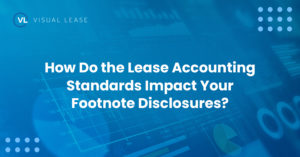
Do your lease footnote disclosures comply with the new lease accounting standards?
The footnotes of your financial statements must include certain information from your lease contracts. And with the newly implemented FASB, GASB and IFRS lease accounting standards, disclosure requirements have become more complicated.
What are footnote disclosures?
Footnote disclosures explain how an organization determined the numbers in their financial statements, such as their balance sheet (or statement of financial position), cash flow statements and income statement (or statement of activities). They highlight any differences the organization has made to its accounting methodologies from previous years and give an overall sense of its current and projected financial well-being.
Organizations must also fully disclose future contingencies, commitments and contractual obligations in their financial statements. Often, they use footnotes to provide this information.
How footnote disclosure requirements changed under ASC 842
Before ASC 842, footnote disclosure requirements were less detailed, and many organizations could easily manage their leases through spreadsheets. But the new lease disclosure requirements are much more complicated, making it nearly impossible to use spreadsheets to manage leases and track updates anymore.
For example, under ASC 840, finance leases (formerly called capital leases) had to be recorded on an organization’s balance sheet, but operating leases didn’t. Instead, they were listed in the footnote disclosures.
Under ASC 842, operating lease assets and liabilities must be “on the books” and recorded on the balance sheet, which can impact the ratios used to measure the organization’s financial health. To avoid confusion, it’s important to explain these differences in the operating lease footnote disclosures in a clear and organized way.
Disorganized footnote disclosures waste time and money
Leases are complex contracts that come in many shapes and sizes. Moreover, they can often be overlooked if not itemized and managed properly, resulting in increased financial risk for an organization.
Proper lease accounting management hinges on accurate footnote disclosures. Inaccurate disclosures can waste accounting professionals’ time and undermine an organization’s operability and reputation.
Furthermore, footnotes that are unclear or disorganized can easily bury important information. This can lead to mistakes and additional costs when preparing the annual financial statements both internally and externally.
The right tool can simplify footnote disclosures
Although footnote disclosures under the new lease standard can be overwhelming and complex, the right tool can vastly simplify the process.
To stay compliant, you’ll want to use a software solution that meticulously tracks lease accounting updates. It should also be easy to use yet robust enough to organize data from various sources.
A comprehensive tool like Visual Lease can generate audit-ready journal entries, disclosures and reports to help you comply with ASC 842, IFRS 16 and GASB 87 lease accounting standards.
The right lease management software should also keep all your lease accounting data in one place so you can easily generate statements and find the insights you need. After all, lease accounting shouldn’t just keep your organization compliant — it should also uncover new strategies to help you save money and time.























